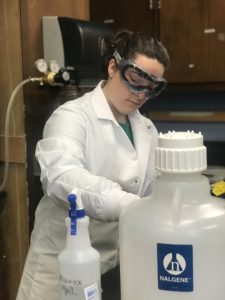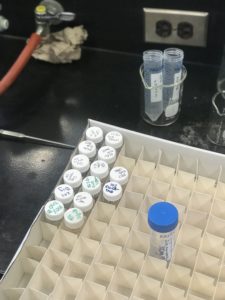
Sophomore Kaitlyn Brasecker in the lab. Photo by Chelsea Komer.
According to a study funded by the National Science Foundation, the NSF estimates by 2020, there will be two million nanotechnology-related jobs/workers needed in the United States. Six million worldwide.
At only 19 years of age and a sophomore at Western Carolina University, Kaitlyn Brasecker hopes to bring advances in the medical field through nanotechnology.
Nanotechnology is an emerging field within solid-state chemistry that emphasizes the production of chemical compounds rather than the engineering aspect of preparing matter in nanometer sizes. In terms of size, the particles are smaller than the diameter of a strand of hair.
Brasecker’s initially came to WCU as a biology major. She wanted to become a medical examiner. She then was invited to join L.E.A.R.N., a program that welcomes STEM (science, technology, engineering, and mathematics) students and introduces them to a living-learning community.
Undergraduate Research Coordinator and Program Coordinator of L.E.A.R.N., Kloo Hansen, says it is a pathway for research programs on campus. While only in year two at WCU, L.E.A.R.N. has made great strides in becoming one of the more hands-on experiences on campus, as well as increasing interactions in research.
“It really is a peer-to-peer driven program,” said Hansen.
During Brasecker’s 12-week apprenticeship in L.E.A.R.N., she had the opportunity to work with Bioinorganic chemist and professor, Channa De Silva, who is now her research mentor.
Brasecker and De Silva are now working together on discovery-based chemistry research involving nanoparticles that will eventually inhibit bacteria growth.
Having only taken her first chemistry class first semester of her sophomore year, Brasecker said that having a problem that wasn’t already solved spiked her interest in chemistry and the project itself.
De Silva said the idea for this specific research originally sparked a few years ago when one of his graduate students began testing Zinc nanoparticles. They noticed that the nanoparticles were showing an inhibiting factor against some bacteria.
“We wanted to modify that. Those nanoparticles were not very good meaning high quality but it worked so we got some good preliminary data,” said De Silva.
Brasecker’s current work consists of regulating the size of the nanoparticles, as well as discovering how to chemically connect them.

Nanoparticles used throughout Brasecker’s research. Photo taken by Chelsea Komer
The research consists of a Zinc Oxide (a metal combined with oxygen) nanoparticle and Europium. Zinc is a common chemical element found in human consumption products, such as diaper rash creams and sunscreen. When mixing the two, the Europium is increased by increments of five (percent-wise), and in turn, creating the best way to test an inhibition zone.
According to Brasecker, she is the first known to record a product of a 15 percent Europium nanoparticle. This result created what she described as hexagonal rods.
Brasecker’s ultimate goal is to create a material that would look and act similar to medical gauze, but with the ability to inhibit bacteria growth. This involves incorporating said material into hospital bed sheets, keeping infections from forming or spreading to patients.
Rather than the material acting as an adhesive, it would attach to the area like a claw.
She would also like to see the success progress into tactical gear.
Take a wounded soldier, for example. Likely waiting days for help, the eventual material created could help eliminate the worry of infection or the spread of one.
While Brasecker will likely face obstacles along the way, the progress already made is encouraging and hopeful.
“I would love to get the patent, put it under a [hospital] bed sheet, and hear my dad say, ‘You see that? My daughter did that!’,” said Brasecker.
Regarding her research, Brasecker is now mentoring two students of her own. Having gone through the L.E.A.R.N. program herself and gaining Dr. De Silva as a mentor, Brasecker now has the knowledge and experience to carry over to other students in the hopes that they, too, gain the value in such a hands-on experience.


